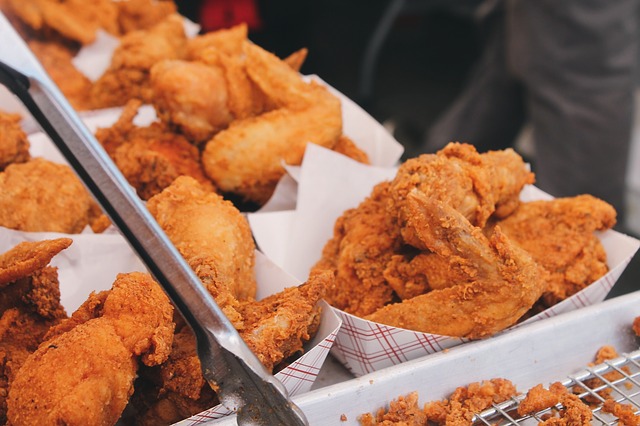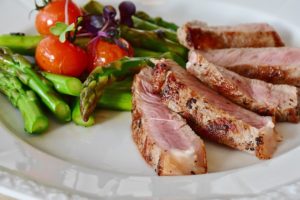Although it is certainly true that there are foods you can eat that have the potential to reduce inflammation and, as a consequence, the symptoms of sciatica, it is also true that there are foods that have potential to drive up inflammation and make sciatica WORSE.
The following list are the foods to avoid when you have sciatica.
Aims of this post:
- To give you a list of 5 of the most harmful foods to avoid when you have sciatica.
- To give you a list of alternatives that have been shown to reduce inflammation and can help to combat the symptoms of sciatica.
Before we dive in, please be aware that we are part of the Amazon Affiliate programme. This page may contain Amazon affiliate links, so if you choose to purchase a product for your sciatica that we recommend through a link on this page, we will receive a small commission at no extra cost to you. This helps us keep Overcome Sciatica alive! Thank you for your support. Please be assured that we only ever recommend products that we truly believe can help.
If you’re not focusing on making your diet the best it possibly can be when you have sciatica, you really are leaving improvements on the table.
I previously wrote about the Top 11 Foods that you should be including in your diet when you have sciatica, due to their inflammatory, pain relieving and weight loss benefits.
You should definitely read that article along with this one for maximum benefits!
However, today we are going to discuss the sciatica foods to avoid – so you can maximise your chances of a rapid recovery.
Why change my diet when I have sciatica?
Food is more than just sustenance. Along with the fact that what you eat goes a long way to controlling your weight, your diet also affects other bodily processes like inflammation, mood and sleep (shown in this study here).
Although inflammation isn’t always bad (it is actually a necessary part of the healing process), we know that controlling chronic, ongoing inflammation is one of the most important factors to recovery from sciatica.
Through making changes to your diet, it is possible to minimise the foods that promote inflammation and lead to other harmful processes in the body, while replacing them with much healthier alternatives that stave off inflammation and help to bring your symptoms under control.
The other side of sciatica foods to avoid –– & why being overweight is TERRIBLE for someone with sciatica
The other benefit you’ll get from making positive changes to your diet is weight loss – something that is crucial for anyone looking for relief from sciatica who also happens to be overweight.
The current research into obesity shows that when someone is overweight, they suffer a whole slew of negative changes within the body.
Excess body fat has been shown to be linked with chronic inflammation, which can directly increase the pain felt in sciatica (as shown in this study here).
Risk of Diabetes
Eating too many of the foods on this list of sciatica foods to avoid will also increase your chances of suffering from type-2 diabetes – a condition that slows down healing all over the body (shown in this study here).
Type-2 diabetes comes about as a result of sustained high levels of sugar intake and is characterised by a resistance to the hormone “insulin”. This important hormone controls how your body reacts to sugar.
Diabetes can lead to high levels of blood sugar, which leads to skin breakdown, unhealthy nerves and difficulty in controlling weight, energy and mood.
Not a happy combination.
Even if you aren’t diabetic, just having a persistently high blood sugar level can also delay healing by interfering with the tissue healing process. This is especially relevant for those suffering from disc bulges.
Another negative effect of being overweight is perhaps the most obvious; more weight equals more stress through the joints and discs in the spine, which directly increases pressure on an irritated sciatic nerve, making symptoms worse for someone suffering from sciatica.
There is even evidence to show that obesity is directly linked to sciatica as a primary risk factor. What’s more, the same researchers found that the more overweight you are, the worse your symptoms!
From my experience, I have found that many painful conditions, not just sciatica, can be significantly helped through dietary changes and weight loss by reducing the stress on tissues within the body.
By knowing about the sciatica foods to avoid, you should also see a positive change to your body weight!
This will give you a HUGE array of benefits – not just less pain. Read on to discover the sciatica foods to avoid…
You can also check out my full guide on how to lose weight easily and comfortably (even when you are unable to exercise) – click HERE!
Sciatica Foods to AVOID –– The Top 5
Now that I’ve laid out my argument for WHY you should make some changes to your diet, let’s now talk about specific foods to avoid when you have sciatica and how you can make healthier substitutions.
#1 – High Sugar
Simple sugars, including sugary drinks, sweets, indulgent desserts, as well as hidden sugars like those in table sauces, are definitely foods to avoid when you have sciatica.
Quite simply, sugar significantly increases inflammation throughout the body when consumed in moderate to high doses and may also lead to type-2 diabetes when consumed in high quantities over prolonged periods.
Both of these problems will lead to a worsening of your symptoms.
Unfortunately, sugar is so easily obtainable in modern day society and is often used as a “secret” ingredient in many foods to improve their taste that it is difficult to avoid all together.
The best way to go about this is to take some time reading the labels of some of the staple foods from your weekly shop; you might be surprised at the sugar content in ready meals and certain sauces.
Cutting out fizzy drinks will significantly reduce your sugar intake if you are a regular fizzy-drinker. In some fizzy drinks, there is as much as 50g of sugar in one 500ml bottle!
For a better option, replace your usual can of coke with a fizzy water and lime – you’ll still get the fizz, just without the unnecessary sugar.
If you’re an avid chocolate fan, here’s the good news – you can satisfy your sweet tooth by substituting your high sugar dessert with some squares of dark chocolate as a reduced-guilt alternative.
A substance found naturally in dark chocolate has the effect of reducing inflammation naturally (see this study here), while you won’t find the same amount of sugar in dark chocolate as the milk variety.
Another thing to watch out for is your fruit juice and fruit intake. While fruits are usually considered “healthy” due to high vitamin and mineral content, there are often high concentrations of fructose within the sweeter fruits, which can has detrimental effects on weight and inflammation when consumed in large quantities.
Consider a less sweet alternative for the very sweet fruits in your diet.
#2 – Vegetable oil
Vegetable oil and sunflower oil are often used in cooking and can lead to worsening inflammation within the body.
Therefore, they hold a significant spot on this list of sciatica foods to avoid.
You’re not necessarily safe just because you don’t use vegetable oil when cooking, though; there are often high levels of vegetable oil found in mayonnaise and BBQ sauce, too. Always check the ingredients label when buying these products.
As an alternative when cooking, use either extra virgin olive oil or virgin coconut oil (both included as one of my Top 11 Foods to include in your diet when you have sciatica).
Both of these products have strong anti-inflammatory properties and are considered far healthier to fry or bake with. Extra virgin olive oil can also be used on salads, while coconut oil adds that great taste to food when used in baking.
#3 – Fried, processed foods
Not just due to the fact that they’ve probably originally been fried in sunflower or vegetable oil, you should definitely steer clear from fried foods.
Fries, onion rings and processed meats as found in “turkey twizzlers” (gulp) are foods to avoid when you have sciatica due to their high fat and pro-inflammatory properties.
Bags of crisps/chips also fall into this category due to the unhealthy way that they are often prepared. They also won’t fill you up when eaten as a snack mid-morning, encouraging a binge later on and consequential weight gain.
A great alternative to crisps is home-baked kale chips.
To make this tasty alternatives to the sciatica foods to avoid: simply heat your oven to 180 degrees centigrade, grease a tray with extra virgin olive oil, spread a packet of kale over the tray and drizzle with a bit more olive oil. Then bake for 20 minutes – that’s it!
You can place these crisps in a bowl, and snack on them over the next few days as they tend to stay nice and crispy for a good length of time. They come under the “green leafy veg” category and will have anti-inflammatory benefits, reducing nerve root irritation and helping to bring down your symptoms. Not bad, eh?
Are You Looking for RAPID Relief from Sciatica?
My good friend, colleague and fellow international sciatica expert, Dean Volk, has a brand new sciatica relief video course available – and I’m delighted to be an official sponsor!
Check out Dean Volk’s “Kicking Sciatica OUT of the Butt!” Online Pain Relief Course Here!
I can proudly recommend Dean and his course for sciatica sufferers – because I’ve seen his incredible results first-hand. You can check out his course (and get lifetime access to the videos and bonus content) by clicking HERE.
#4 – Dough and flour
Pizzas, bread and pasta all contain gluten, which can be difficult for some people to digest and may increase levels of inflammation for others – because of these facts, they are also sciatica foods to avoid. (Here is a link to the study showing how participants’ inflammation levels dropped after cutting out gluten from their diets.)
These foods also tend to lead to hunger quite quickly after a meal, due to their high carbohydrate content. If you remember from school: carbohydrates are a good energy source but they are used by the body very quickly, with any not used for energy is stored as fat.
A nice alternative to try for a few weeks is gluten-free alternatives; I have spoken to some patients who found that they were in fact suffering from a low level gluten intolerance and as such were suffering from weight gain and gastric issues without realising gluten was the cause.
By stopping gluten and replacing it with gluten-free bread and pasta, they found a huge array of unexpected benefits.
Maybe you can get similar benefits from this one simple change, too.
#5 – Artificial sweeteners
I know I said avoid sugary drinks and sodas, but if you’re about to reach for the Diet Coke, not so fast!
The sweeteners that make these drinks palatable may have negative effects on inflammatory processes within the body. There is also some research to show that these sweeteners actually increase sugar cravings (because your body expects sugar to come from something sweet – so is disappointed to not receive it from your diet beverage).
Fortunately, there are some tasty alternatives to artificial sweeteners that you can easily substitute into your diet.
If you use an artificial sweetener in your tea or coffee, instead try a teaspoon of honey mixed into your drink. You’ll get that gorgeous sweet taste while also preventing the negative effects of refined sugar and artificial sweeteners.
If you like a sugary drink more than anything, try this blended super-fruit smoothie instead:
Mix a banana, handful of strawberries, handful of blueberries, ice cubes and 2 tablespoons of Greek yoghurt and blend for 2 minutes for a smooth, sweet alternative. This smoothie is packed with “super foods” which can potentially reduce inflammation as well as keeping hunger at bay for longer.
Summary
If you manage to leave out these foods to avoid when you have sciatica, and include some of my Top 11 Foods for sciatica relief, you should see a significant benefit in your recovery journey. I hope you’ll agree that the substitutions I have suggested in this article are affordable and manageable.
If you try these substitutions, I’d love to hear how you’re getting on! Why not drop a line into the comments section to let me (and the other readers) know about your progress or if you have any ideas of your own for things that have worked for you?
Equally, if you have experienced any foods that made your symptoms worse and you feel they should be added to this list of foods to avoid when you have sciatica, drop me a line and let me know!
Top Tip: Grab a copy of my #1 Best-Selling book, Thriving Beyond Fifty for more health, wellness and recovery strategies!
Are You Looking for RAPID Relief from Sciatica?
My good friend, colleague and fellow international sciatica expert, Dean Volk, has a brand new sciatica relief video course available – and I’m delighted to be an official sponsor!
Check out Dean Volk’s “Kicking Sciatica OUT of the Butt!” Online Pain Relief Course Here!
I can proudly recommend Dean and his course for sciatica sufferers – because I’ve seen his incredible results first-hand. You can check out his course (and get lifetime access to the videos and bonus content) by clicking HERE.
The information on Overcome Sciatica should never be used as a substitute for medical advice from a doctor. Never put into action any tips or techniques from Overcome Sciatica without checking with your doctor first. Please see full terms of use here.











I will do these Things thank you God Bless
Thank you For helping me to Make better Food Choices for my Heath
A very good read. I like your honesty. I have been thinking to myself that weight loss makes sense but not one professional will mention it. The gluten is one I have not thought of and I will try alternatives. Thank you so much.